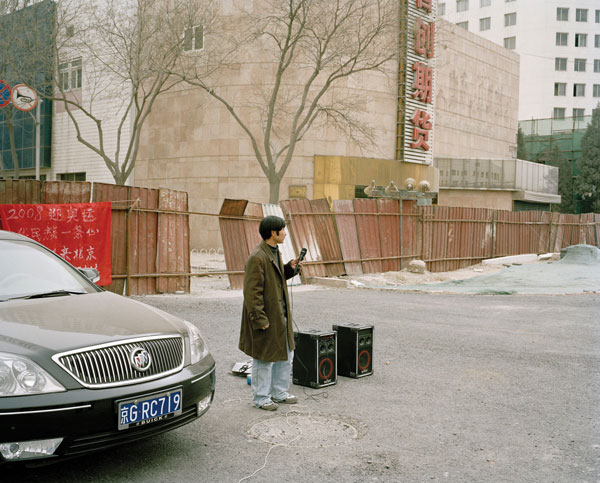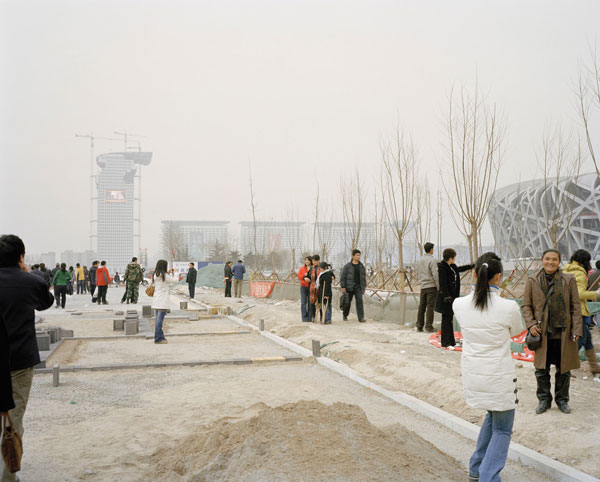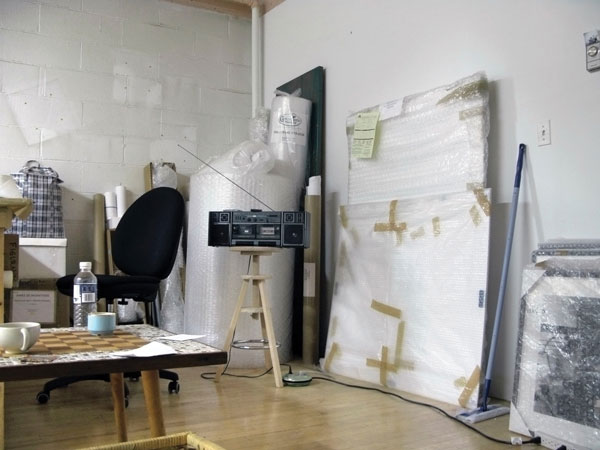[Summer 2010]
par James D.Campbell
Raymonde April
Equivalences 1-4 Galerie Donald Brown, Les Territoires, Occurrence, Montréal
January 9 to March 13, 2010
Why is it that Raymonde April’s art always occupies the foreground of my consciousness when I think about photography – about what it is and what it can be ? Even as flashier and more graphically cinematographic photography rules the proverbial roost in the art world right now, April, a maverick artist, has long since staked out her territory and made it her wholly and uniquely her own.
If April’s work is a touchstone for interpreters and art lovers like myself, it is because her photographs are clearly the work of a poet who openly embraces the world of everyday life. A poet who, instead of being carried away by hurly-burly cinematic effects and hyperbole, keeps her ear pressed close to the chest of human subjects – and the landscape as lived – so as to hear the resilient and never-boring beating of a human heart. In her overwhelmingly porous art, binary sets of seemingly opposed traits and values – an always-youthful inquisitiveness wed to resolute tenacity, on the one hand, and a prosaic (but never cornpone) sensibility dovetailed with a deeply entrenched poetic vision of the lived world, on the other – coexist in an unlikely, even exalting, harmonic balance.
The myriad ghosts of things seen empower metaphor when embedded in the symbiotic relationship between human beings and the places they inhabit – a fact that April knows well. The multiple exhibitions recently held in Montreal, titled Equivalences 1–4 and curated by Eduardo Ralickas, are really about poeisis and the prosaic, ecstatic time and affirmative depth, as being radically equivalent in her work.
The distance between Personnages au Lac Bleu, her first installation, and the works shown at Galeries Donald Brown, Les Territoires, and Occurrence, is historically daunting but decidedly redeemed by her devotion and integrity and the sheer cohesiveness of her creative vision. She has always remained true to her own maverick vision of poeisis and the prosaic life. In so doing, she has achieved something like aesthetic grace.
When I say “prosaic,” I do not mean in the sense of lacking in imagination or spirit or resembling prose but in the sense of being straightforward, close to the life-world, unadorned and free of the theoretical concerns that sometimes mire photographic practice in the baroque, extraneous, and pedantic. When we look hard and long at her images, their meaning – as though one could “solve” their formal beauty and introspective mien as mere idylls of the prosaic life – is less important than is our heightened engagement in seeing by virtue of the simple and selfless poetics that always inform them. Simply put, April’s photographs remind us of what it is to be a human being, to be alive.
She may photograph the “hard facts” of our existence – whether in the inner city, in the country, or by the seaside – and yet she always evokes something numinous before and after those facts, however quotidian and unprepossessing they seem to be. She tackles a latent semiotic plenum that informs the fabric of a commonly experienced world, whether in family, inhabited spaces, or quirky souvenirs of the everyday.
If, as some commentators have held, every image has its own duration, well, that duration can be multiple, just as every image has its own spatial modalities, predicated upon its interwoven matrices within place and the infinite, unfurling horizon of human subjectivity. April’s photographs mark out a geography that is at once intimate and heartfelt. If we are attuned to them, we sense both their intimacy and universality, and are moved as a result. And we are almost always attuned to them. Furthermore, they are all about incubation, and a radical enframing of what her eye seizes upon, and not the immaculate conception of meaning in a given frame that she, of course, abjures.
April seizes upon the present instant of seeing, but the images carry within them both atavisms of the past and portents of the future. Which is only to suggest that, in her images, more than one tense may be present at the same time. Duration is coeval therein not only within the gestation of images, but in their seizure and aurae, and those images speak of a time not only elastic, stretching out from the past and into the future, but ecstatic as well.
Her images are icons of temporal convergence.
Nicole Gingras once insightfully said (and it is still pungent and still true), Raymonde April shares with certain poets a relationship to the moment wherein emotions are condensed into the events recounted or described. Like them, Raymonde April works from “details” that hold her attention, fascinating fragments that maintain a metonymic relationship with the world. A dialogue then operates between what is looked at, photographed, reframed and retained, and the reality from whence the photographed instant proceeds.1
Yes, she captures something of the truth of April’s project, a truth of how parts conjure up worlds, of how parts become worlds in their own right and constitute scaffoldings for those worlds that can be extraordinarily revealing. Her humility and the syntagmatic integrity inherent in her images enable a transformation into dialogue, and thus the work never devolves into muted soliloquy or closed-in, opaque meanings.
Her optic is phantasmatically nomadic, a trait shared by photographers as disparate as Isabelle Hayeur and the young Moscow-born savant Yuula Benivolski. We sense that her goal is only to arrive at a place where her images may tell their own truth. Her work does not shy away from its own scar tissue, for it is overwhelmingly resilient rather than fragile, like epidermal tissue that renews itself time and time again, getting dimensionally thicker all the while.
And April’s vision is overwhelmingly tactual. Our eye, alongside hers, moves voluptuously and voraciously over the surface of things, palpating both what is visible, given, on the exterior – and that which is invested, interiorized, and withheld. April is, in one sense, always outside herself, always ready to seize the moment and reveal it as being highly stratified and possessing enormous depth. She accepts, stoically and without regret, the condition of being here – of being, that is, in a world. With hard-won serenity and an exalting measure of poiesis, she is wholly open to the world, she welcomes it within herself, her images, almost as a sacred trust of what it means to see and be a witness of what is seen.
April images “make present,” which does not mean only that they bring us home to the here and now of our experiencing but that they achieve a vital “presencing” that comprises both disclosure and concealment. Her practice incarnates a remarkable ethic of making in this sense. Poeisis equates knowing with making, incorporates both, and April effectively uncovers and retrieves the wayward and often ignored poetic essence of everything that comes under her purview.
In all of her work to the present day, we can eavesdrop on Raymonde April saying to herself something like “J’accepte.” “I accept.” This is different in kind from choosing a specific moment in time per se, and preserving it as a worthy relic of the prosaic life – and is thus an inverted proprietary gesture on her part. A stoic of no small persuasion, her ongoing acceptance of the world and its inhabitants imbues her work with a deliberate serenity that is as at once tactually felt and uplifting for her viewers.
1 Nicole Gingras, “Les Images soeurs et autres textes,” in Raymonde April, Les Fleuves invisibles (Joliette: Musée d’art de Joliette, 1997), p. 21-62.
James D. Campbell is a writer on art and independent curator based in Montreal. The author of over 100 books and catalogues on contemporary art and artists, he contributes frequently to visual arts publication across Canada.




